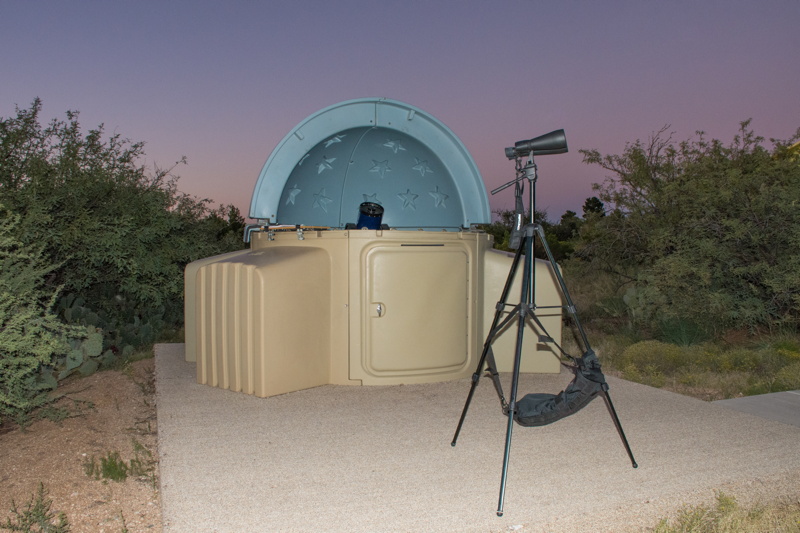New Smartphone Afocal Adapter Tests, NightCap Pro Double Cluster
Posted: 30 September 2015
Monday, 28 September 2015, had clouds come in during the day. Tuesday was clear however.
|
Open: Tuesday, 29 September 2015, 1805 MST Temperature: 98°F |
Session: 863 Conditions: Clear |
1813 MST: sunset. Set up my Celestron Cometron 12x70 binoculars on a tripod:

1824 MST: viewed Saturn, 83X and 222X. The view was surprisingly good at 222X with Saturn low in the southwestern sky. 1831 MST: Saturn was just barely naked eye visible in the twilight sky. 1840 MST: Saturn's moon Titan was now visible, 222X, but the seeing at Saturn was getting worse.
Switched back to 83X and viewed M8 (Lagoon Nebula) and then M20 (Trifid Nebula). Both were faintly visible against the still twilight sky. Astronomical Twilight would end this night just as the waning gibbous Moon would rise about 1935 MST. 1906 MST: the views of M8 and M20 were better now. Added the f/6.3 focal reducer and switched to a 40mm eyepiece (yielding 32X). The wide field, low magnification view of the Lagoon Nebula was nice. Viewed M31 (the Great Andromeda Galaxy), 32X. Very good view of M31 with the companion galaxies M32 and M110 nicely in the same field-of-view (FOV).
Next, viewed M31 using the 12x70 binoculars. M32 was also visible. Then viewed the Double Cluster (open star clusters) with the binoculars.
1925 MST: returned to the 8" LX200-ACF telescope and viewed the Double Cluster at 32X (40mm eyepiece + focal reducer). Lovely view. Began setting up for afocal imaging of the Double Cluster using the iPhone 5s with my new Orion SteadyPix adapter (review in progress). Switched to a 26mm eyepiece + focal reducer (48X). This image was taken using NightCap Pro v7 using Long Exposure, Light Boost, ISO 8000, 1/2sec shutter speed, 60 seconds exposure:

This image was with NightCap Pro v7 using Light Boost, ISO 3200, 1/2sec shutter speed:

Both images are amazing for a smartphone camera.
2000 MST: began waiting for the waning gibbous Moon to rise over the hill to the east, which it did at 2020 MST, as seen in this iPhone photo, 48X:

2030 MST: viewed the Moon in the 12x70 binoculars. Lovely.
After the Moon was above the hill and out of a tree near the observatory, I took this iPhone adocal photo, 48X, at 2042 MST:

Before closing up for the night I took a last look at the Moon, 83X.
|
Close: Tuesday, 29 September 2015, 2107 MST Temperature: 76°F |
Session Length: 3h 02m Conditions: Clear |
I missed acknowledging the 10th anniversary of my visit to Oracle Observatory on 24 September 2005.
Comments are welcome using Email. If you are on Twitter you can use the button below to tweet this report to your followers. Thanks.
Cassiopeia Observatory Home Page
Copyright ©2015 Michael L. Weasner / mweasner@me.com
URL = http://www.weasner.com/co/Reports/2015/09/30/index.html
